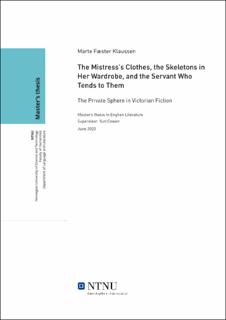| dc.contributor.advisor | Cowan, Yuri | |
| dc.contributor.author | Klaussen, Marte Fæster | |
| dc.date.accessioned | 2021-09-24T18:32:45Z | |
| dc.date.available | 2021-09-24T18:32:45Z | |
| dc.date.issued | 2020 | |
| dc.identifier | no.ntnu:inspera:55982108:36747723 | |
| dc.identifier.uri | https://hdl.handle.net/11250/2781880 | |
| dc.description.abstract | I lys av tre utvalgte romaner, og deres historiske kontekst, bruker denne masteroppgaven materiell kultur til å argumentere for at objekter bidrar til å endre roller og forhold i den viktorianske husholdningen. Nærmere bestemt, mellom husfruen, tjenerne og herskapshuset. I tillegg viser masteroppgaven også hvordan objekter bidrar til å gjøre hjemmets private sfære offentlig. Braddons Lady Audley’s Secret, Woods East Lynne og Brontës The Tenant of Wildfell Hall, har alle blitt valgt fordi de omhandler husholdninger som ender opp med å feile. I disse romanene undersøkes husfruens klær for å vise hvordan klærs offentlige betydning kan gjøre husfruen om til et utstillingsobjekt og påvirke hennes rolle i husholdningen og hvordan folk behandler henne. Når det kommer til tjenerne, som familien forventet skulle være usynlige, fokuserer masteroppgaven på farger – eller mangel på farger – for å vise effekten slike nyanser hadde på husfrue-tjenerforholdet. Sist men ikke minst, ser denne masteroppgaven på husets arkitektoniske egenskaper og hvordan disse, fysisk, påvirket roller og forhold. Oppgaven fokuserer spesielt på dører, vinduer og vegger for å vise hva de gir tilgang til og hva de stenger ute, og konsekvensene dette medfører. Denne masteroppgaven ser derfor på både objektets metafysiske og fysiske attributter gjennom semiotiske og fenomenologiske tilnærminger. Det som blir tydelig i spørsmålet om objektets rolle i endringen av husholdningsdynamikken, er at objektets innflytelse i endringen av sfære, forhold og roller avhenger like mye av menneskene som opplever og tilegner objektet en betydning som objektet selv. | |
| dc.description.abstract | In light of three selected novels, and their historical context, this thesis uses material culture to argue that objects contribute in changing roles and relationships within the Victorian household. Namely, between the mistress, the servants and the estate. In addition, the thesis also shows how objects contribute in turning the private sphere of the home public. Braddon’s Lady Audley’s Secret, Wood’s East Lynne and Brontë’s The Tenant of Wildfell Hall, have all been chosen because they feature households that fail. In these novels, the mistress’s clothes are examined, showing how the public meaning of clothes could turn the mistress into an object on display, affecting her role in household management and how people treated her. When looking at the servants, expected by the family to be invisible, the thesis turns to colours – or lack of colours – to show the effect such tints have on the mistress-servant relationship. Lastly, this thesis turns to the architectural features of the home and how they physically impacted on roles and relationships. The thesis particularly focuses on doors, windows and walls to show what they give access to and what they deny, and the consequences that follow. This thesis therefore looks at both the object’s metaphysical and physical attributes, relying on semiotic and phenomenological approaches. In the question of the object’s role in changing the household’s dynamic, what becomes clear, is that the object’s impact in changing spheres, relationships and roles depends just as much on the people who experience and assign meaning to the object as the object itself. | |
| dc.language | | |
| dc.publisher | NTNU | |
| dc.title | The Mistress's Clothes, the Skeletons in Her Wardrobe, and the Servant Who Tends to Them: The Private Sphere in Victorian Fiction | |
| dc.type | Master thesis | |
